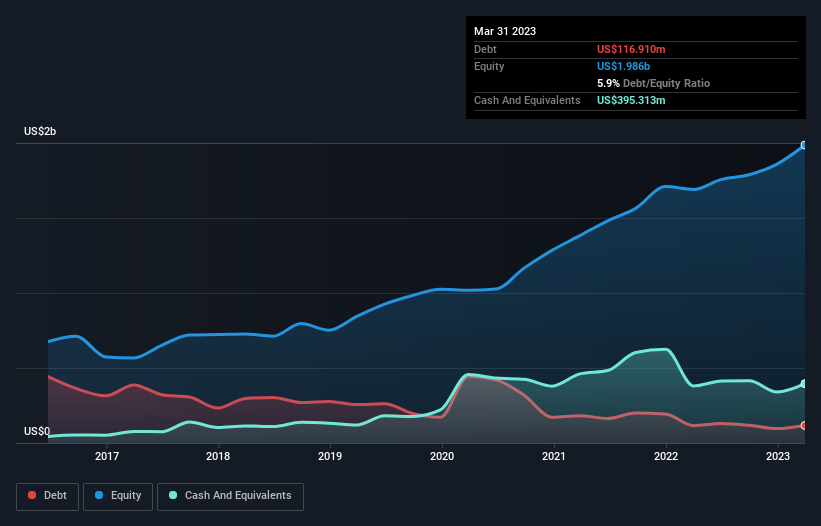- United States
- /
- Machinery
- /
- NYSE:GGG
These 4 Measures Indicate That Graco (NYSE:GGG) Is Using Debt Safely
David Iben put it well when he said, 'Volatility is not a risk we care about. What we care about is avoiding the permanent loss of capital.' When we think about how risky a company is, we always like to look at its use of debt, since debt overload can lead to ruin. We can see that Graco Inc. (NYSE:GGG) does use debt in its business. But the real question is whether this debt is making the company risky.
When Is Debt Dangerous?
Debt assists a business until the business has trouble paying it off, either with new capital or with free cash flow. In the worst case scenario, a company can go bankrupt if it cannot pay its creditors. While that is not too common, we often do see indebted companies permanently diluting shareholders because lenders force them to raise capital at a distressed price. Of course, the upside of debt is that it often represents cheap capital, especially when it replaces dilution in a company with the ability to reinvest at high rates of return. When we think about a company's use of debt, we first look at cash and debt together.
View our latest analysis for Graco
What Is Graco's Debt?
The chart below, which you can click on for greater detail, shows that Graco had US$116.9m in debt in March 2023; about the same as the year before. However, its balance sheet shows it holds US$395.3m in cash, so it actually has US$278.4m net cash.

How Healthy Is Graco's Balance Sheet?
The latest balance sheet data shows that Graco had liabilities of US$381.7m due within a year, and liabilities of US$178.2m falling due after that. Offsetting this, it had US$395.3m in cash and US$356.5m in receivables that were due within 12 months. So it actually has US$191.9m more liquid assets than total liabilities.
Having regard to Graco's size, it seems that its liquid assets are well balanced with its total liabilities. So it's very unlikely that the US$13.2b company is short on cash, but still worth keeping an eye on the balance sheet. Succinctly put, Graco boasts net cash, so it's fair to say it does not have a heavy debt load!
Also good is that Graco grew its EBIT at 17% over the last year, further increasing its ability to manage debt. When analysing debt levels, the balance sheet is the obvious place to start. But it is future earnings, more than anything, that will determine Graco's ability to maintain a healthy balance sheet going forward. So if you want to see what the professionals think, you might find this free report on analyst profit forecasts to be interesting.
But our final consideration is also important, because a company cannot pay debt with paper profits; it needs cold hard cash. Graco may have net cash on the balance sheet, but it is still interesting to look at how well the business converts its earnings before interest and tax (EBIT) to free cash flow, because that will influence both its need for, and its capacity to manage debt. Over the most recent three years, Graco recorded free cash flow worth 53% of its EBIT, which is around normal, given free cash flow excludes interest and tax. This cold hard cash means it can reduce its debt when it wants to.
Summing Up
While it is always sensible to investigate a company's debt, in this case Graco has US$278.4m in net cash and a decent-looking balance sheet. And we liked the look of last year's 17% year-on-year EBIT growth. So we don't think Graco's use of debt is risky. Over time, share prices tend to follow earnings per share, so if you're interested in Graco, you may well want to click here to check an interactive graph of its earnings per share history.
Of course, if you're the type of investor who prefers buying stocks without the burden of debt, then don't hesitate to discover our exclusive list of net cash growth stocks, today.
New: Manage All Your Stock Portfolios in One Place
We've created the ultimate portfolio companion for stock investors, and it's free.
• Connect an unlimited number of Portfolios and see your total in one currency
• Be alerted to new Warning Signs or Risks via email or mobile
• Track the Fair Value of your stocks
Have feedback on this article? Concerned about the content? Get in touch with us directly. Alternatively, email editorial-team (at) simplywallst.com.
This article by Simply Wall St is general in nature. We provide commentary based on historical data and analyst forecasts only using an unbiased methodology and our articles are not intended to be financial advice. It does not constitute a recommendation to buy or sell any stock, and does not take account of your objectives, or your financial situation. We aim to bring you long-term focused analysis driven by fundamental data. Note that our analysis may not factor in the latest price-sensitive company announcements or qualitative material. Simply Wall St has no position in any stocks mentioned.
About NYSE:GGG
Graco
Designs, manufactures, and markets systems and equipment used to move, measure, mix, control, dispense, and spray fluid and powder materials in the Americas, Europe, the Middle East, Africa, and the Asia Pacific.
Flawless balance sheet average dividend payer.
Similar Companies
Market Insights
Community Narratives



